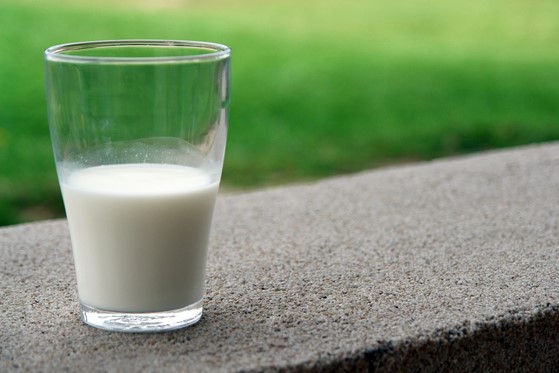
I learned this today. Cows combine nutrients from their blood, sugar, fat, and water in their udders to produce milk.
All mammals, except for monotremes (like the duck billed platypus) produce milk. In all but one case the milk is produced by the female mammal. The only male mammal that produces milk is the Dayak fruit bat. Nobody seems to know why the male lactates. There is a theory that it started to take some of the pressure off the female fruit bat and the females began to select the males that could lactate. This conferred an advantage to those bats, they mated more, and the mutation was passed on. I’m surprised the same thing hasn’t happened with humans.
Why do mammals produce milk? The theory is that they evolved from the brood pouch that fish use to keep and nourish their eggs. All mammals can lactate, so they must have evolved the ability to do it before the last common ancestor of all mammals, in the middle to late Triassic period, about 237 million years ago. Milk probably started as a fluid rich in nutrients that was used to keep the eggs moist and nourished. This slowly evolved into a nutrient-rich milk, which meant that eggs could become smaller because they could get their nutrients from the milk, rather than from the yolk. And then they stopped being eggs.
Why do humans drink milk from other animals? Humans domesticated cows by about 9000 BC. In the beginning, the animals were just used for meat, but humans were drinking their milk by at least 7000 BC. This is shown by pottery that has been found with lipid residue on it. An interesting fact is that we are able to drink milk into adulthood. Most mammals lose the ability to digest milk after they are weaned. They become lactose intolerant. When mammals are drinking milk and growing, their small intestine produces a digestive enzyme called lactase. This breaks down the lactose that is in milk, enabling the body to digest it. Once they are weaned, all mammals stop producing this enzyme and become lactose intolerant. At some point in the past, humans evolved to keep producing this enzyme after they are weaned and became lactase persistent. This allowed them to drink the milk of other animals and use it as a source of nutrition. It also conferred other advantages, such as being able to absorb more calcium, and use milk as a fluid in arid climates. Not all people possess this ability, and those that don’t are lactose intolerant.
So, how do cows produce milk? A cow can only produce milk if it has recently given birth. While it is pregnant, hormones, such as progesterone and estrogen are produced. These hormones trigger the growth of the milk duct system within the udder. Without this happening, the cow won’t produce milk.
The process starts with the food the cow eats. Cows eat about 10 to 12 kg of food a day, usually grass. This grass passes into the first of their four stomachs. This is called the rumen and it is used to ferment the food. Microbes and bacteria start to break the food down. It is much more difficult to digest grass than it is meat, which is why we can’t eat grass. The microorganisms in the cow’s stomach can break down the cellulose and carbohydrates to make volatile fatty acids.
Cows tend to swallow their food without chewing, so the fermenting food is regurgitated out of the rumen back into the cow’s mouth several times so it can be chewed up into smaller bits. This is called chewing the cud. The rumen can hold up to 25 kg of food.
When it has been broken down as much as possible in the rumen, the food is passed through the next stomach, the reticulum, into the third stomach, the omasum. The omasum squeezes as much water out of the partially digested food and absorbs as many nutrients as possible before the food is passed on into the fourth stomach, the abomasum. The abomasum is like our stomachs and breaks down what’s left of the food.
Once the nutrients are in the blood, they pass around the cow, before ending up in the udder. The udder contains connective tissue and secreting tissue. Cows for dairy farming have been selectively bred to have a much larger amount of secreting tissue than natural cows. The presence of estrogen and progesterone in the blood cause more secreting tissue to be produced. The milk is made in the secreting tissue. When the calf is born, the levels of progesterone fall and the hormone prolactin is released, making cells in the secreting tissue take water, nutrients, proteins, fats, and sugars from the blood supply and combine them into milk. The milk is passed through the alveoli, down the milk ducts, and stored in the udder.
When the calf (or the milking machine) sucks the teat on the cow’s udder, nerves stimulate the release of the hormone oxytocin, which makes the muscles contract and pushes the milk out. The prolactin hormone makes more milk as soon as there is space and continues to repeat this for about 10 months. This is why dairy cows are milked twice a day. The average dairy cow can produce about 9,000 liters of milk in a year. They are then “dried off” for about two months before they are artificially inseminated and the whole process starts again. And this is what I learned today.
Photo by Pixabay from Pexels: https://www.pexels.com/photo/blur-calcium-close-up-dairy-236010/
Sources:
https://en.wikipedia.org/wiki/Dairy_cattle
https://en.wikipedia.org/wiki/Milk
https://www.organicvalley.coop/blog/from-grass-to-glass-how-do-cows-make-milk/
https://www.highlightskids.com/explore/science-questions/how-do-cows-produce-milk
https://en.wikipedia.org/wiki/Lactation
https://en.wikipedia.org/wiki/Dayak_fruit_bat
https://en.wikipedia.org/wiki/Lactase_persistence
https://en.wikipedia.org/wiki/Udder
https://www.groupe-esa.com/ladmec/bricks_modules/brick01/co/ZBO_Brick01_2.html
